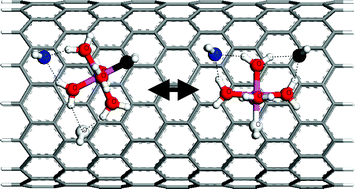Tuning the energy barrier of water exchange reactions on Al(iii) by interaction with the single-walled carbon nanotubes
Abstract
The limiting dissociative (D) and interchange dissociative (Id)

* Corresponding authors
a
College of Chemistry and Life Science, Zhejiang Normal University, Jinhua City, China
E-mail:
qianzhaosheng@zjnu.cn;cjr@zjnu.cn
Fax: +86 579 82282269
Tel: +86 579 82282269
The limiting dissociative (D) and interchange dissociative (Id)

 Please wait while we load your content...
Something went wrong. Try again?
Please wait while we load your content...
Something went wrong. Try again?
H. Feng, Z. Qian, C. Wang, C. Chen and J. Chen, Dalton Trans., 2011, 40, 4183 DOI: 10.1039/C0DT01582B
To request permission to reproduce material from this article, please go to the Copyright Clearance Center request page.
If you are an author contributing to an RSC publication, you do not need to request permission provided correct acknowledgement is given.
If you are the author of this article, you do not need to request permission to reproduce figures and diagrams provided correct acknowledgement is given. If you want to reproduce the whole article in a third-party publication (excluding your thesis/dissertation for which permission is not required) please go to the Copyright Clearance Center request page.
Read more about how to correctly acknowledge RSC content.
 Fetching data from CrossRef.
Fetching data from CrossRef.
This may take some time to load.
Loading related content
